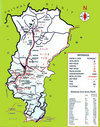Swat fighting as deadly as Iraqi insurgency
Map of Swat. Click map to view.
More than two months after the Pakistani military launched an operation to clear the district of Swat in the Northwest Frontier Province, pockets of Taliban forces and safe havens remain. The Pakistani military and police have taken casualties comparable to the combined US and Iraqi forces have fighting the insurgency in Iraq, according to an Interior Ministry report obtained by the Daily Times.
Military and police casualties in Swat comparable to Iraq over past year
The most telling information from the Interior Ministry's status report on Swat is the casualty data. The Pakistani security forces operating in the small district lost 195 soldiers, policemen, and Frontier Constabulary paramilitaries over the past year.
The Pakistani military has been keen to report the killing or capturing of Taliban forces in Swat, but has withheld data on military and police casualties. While hundreds of Taliban were reported killed or captured, only a fraction of the security forces casualties were reported.
The Taliban insurgency in Swat is as dangerous as the Iraqi insurgency at this point in time. The Iraqi security forces and the US military lost 2,840 soldiers and police in Iraq from between January 2007 through 2008, compared to 195 in Swat. Taking into account Swat's size and population compared with Iraq - 684 square miles and a population of 1.5 million compared to Iraq's 169,234 square miles and nearly 27 million - the insurgency in Swat extremely dangerous. Adjusting for population, the rate of casualties is higher in Swat than in Iraq.
These numbers do not include data from the South Waziristan and Orakzai tribal agencies, where Pakistani troops are currently fighting the Taliban in active, open battles, as well as South Waziristan, Tank, Bannu, Bajuar, where numerous attacks occur on a daily basis. Factoring the South Waziristan and Orakzai numbers, as well as the attacks against police, paramilitaries, and soldiers throughout Pakistan, and the Taliban insurgency is very likely the hottest conflict in the Long War.
Swat's safe havens
The Taliban still maintain four "major" safe havens and 14 "small hideouts," in Swat, the Interior Ministry report stated. "The majority of militants were hiding in Kabal, Khawanza Khola, Matta, and Minogra," the Daily Times reported. The Taliban are also sheltering in "14 valley suburbs" in Totano Bandi, Bagh Dehrai, Manja, Salanda, Sarkhorai, Manosar, Guli Bagh, Shakardara, Sambat, Namal Gat, Shawar, Pewchar, Chupriyal, and Manglawar.
While the military classified Kabal, Khawanza Khola, and Matta as cleared on Dec. 3, 2007, these areas are stilled considered "remaining militant hideouts." The Pakistani military claimed Swat would be cleared and its resorts would be reopened by Dec. 15, 2007.
The neighboring district of Shangla, which was overrun by the Taliban on Nov. 14, 2007, was "secured and reoccupied" on Nov. 29, according to the report.
Swat is only part of the problem
The Pakistani government and military hope to regain control of Swat by continuing military operations, establishing local security forces, providing services, and strengthening the justice system, according to the Interior Ministry report. But while Pakistani security forces focused on Swat during the past two months, adjacent districts and tribal agencies in the North remain under the sway of the Taliban. The Taliban remain strong in the districts of Dir, Chitral, Kohistan, Malakand, and Buner. In order for the Pakistani Army to move forces through Malakand, it had to impose a curfew in the district.
The Bajaur tribal agency remains a stronghold of Faqir Mohammed, the 28-year-old radical leader of the local al Qaeda-linked and outlawed Tehrik-e-Nifaz-e-Shariat-e-Mohammadi (TNSM - the Movement for the Implementation of Mohammad's Sharia Law). Faqir has close connections to al Qaeda's Ayman al Zawahiri. Bajaur is an al Qaeda command and control node for operations across the border in eastern Afghanistan. The TNSM is also referred to as "the Pakistani Taliban." This banned terror group sent over 10,000 of its fighters into Afghanistan to fight US forces in 2001 and 2002 before the fall of the Taliban.
The Pakistani military has failed to capture the leader of the Swat insurgency. Swat TNSM leader Maulana Fazlullah has so far eluded the Pakistani security forces and routinely broadcasts on his illegal FM radio channel to incite violence. While many of Fazlullah's aides have been captured, the military has begun to release some of his lieutenants. Eight of Fazlullah's deputies were freed on bail on Feb. 2.
The release of Fazlullah's aides indicates the government may be looking for a political settlement. At the onset of the Swat offensive, the Pakistani government released Sufi Mohammed, the ideological leader of the TNSM in the Northwest Frontier Province, and promised it would allow for the imposition of sharia law. Sufi's release was endorsed by General Ahmed Shuja Pasha, the Director General of military operations in the region. "Shuja calls [Sufi's release] part of the 'political effort' needed to accompany the military campaign," Time reported in November 2007. "Brute use of force alone would only take us backwards," said Shuja. The release of Sufi and the declaration of sharia were two of Fazlullah's demands to end attacks against the government.
Pakistani government reacting to the Taliban in the Northwest Frontier Province
The military is currently fighting on three active fronts in the Northwest Frontier Province: South Waziristan in the South, Orakzai in the Center, and Swat in the North. The fighting in Swat, South Waziristan and Orakzai has been initiated by the Taliban after they attacked military and government facilities and took open control of territory. The Taliban have been reported to have plans to launch an offensive against Peshawar in the spring of 2008.
Without a comprehensive plan to address the rise of the Taliban and extremism in the Northwest Frontier Province, the recent military gains in Swat may be short lived. As repeated peace agreements in North and South Waziristan, Swat, Bajaur, and Mohmand demonstrate, cutting deals with the Taliban only gives them the time and space to consolidate their control and expand outward.
Correction: This article initially stated the Pakistani security forces encountered 195 casualties in January 2008. The numbers were actually from January 2007 through January 2008. The number of security forces killed in Swat is still comparable to the number of US and Iraqi forces killed in the insurgency when adjusting for population.





















